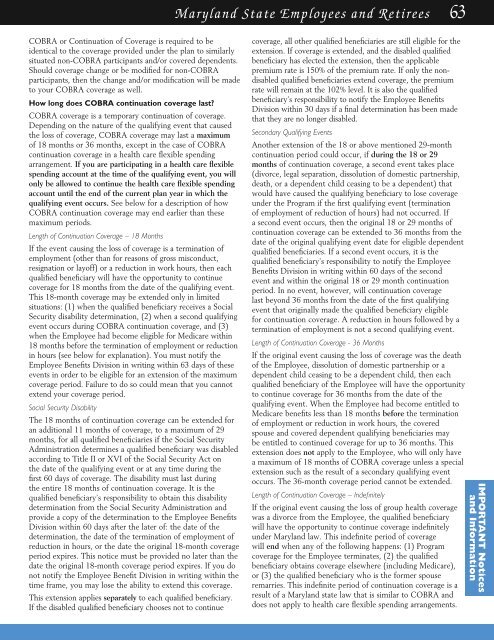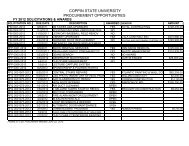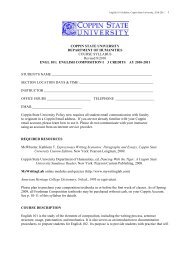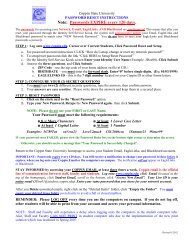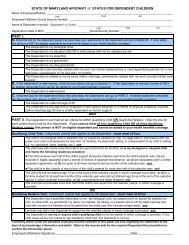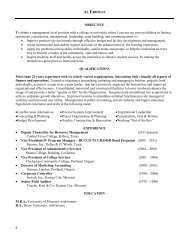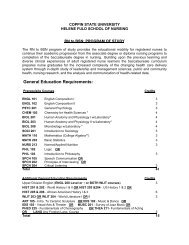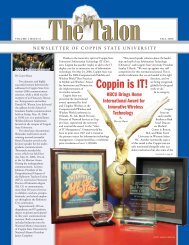FY2011 Health Benefits Booklet
FY2011 Health Benefits Booklet
FY2011 Health Benefits Booklet
Create successful ePaper yourself
Turn your PDF publications into a flip-book with our unique Google optimized e-Paper software.
Maryland State Employees and Retirees 63<br />
COBRA or Continuation of Coverage is required to be<br />
identical to the coverage provided under the plan to similarly<br />
situated non-COBRA participants and/or covered dependents.<br />
Should coverage change or be modified for non-COBRA<br />
participants, then the change and/or modification will be made<br />
to your COBRA coverage as well.<br />
How long does COBRA continuation coverage last?<br />
COBRA coverage is a temporary continuation of coverage.<br />
Depending on the nature of the qualifying event that caused<br />
the loss of coverage, COBRA coverage may last a maximum<br />
of 18 months or 36 months, except in the case of COBRA<br />
continuation coverage in a health care flexible spending<br />
arrangement. If you are participating in a health care flexible<br />
spending account at the time of the qualifying event, you will<br />
only be allowed to continue the health care flexible spending<br />
account until the end of the current plan year in which the<br />
qualifying event occurs. See below for a description of how<br />
COBRA continuation coverage may end earlier than these<br />
maximum periods.<br />
Length of Continuation Coverage – 18 Months<br />
If the event causing the loss of coverage is a termination of<br />
employment (other than for reasons of gross misconduct,<br />
resignation or layoff) or a reduction in work hours, then each<br />
qualified beneficiary will have the opportunity to continue<br />
coverage for 18 months from the date of the qualifying event.<br />
This 18-month coverage may be extended only in limited<br />
situations: (1) when the qualified beneficiary receives a Social<br />
Security disability determination, (2) when a second qualifying<br />
event occurs during COBRA continuation coverage, and (3)<br />
when the Employee had become eligible for Medicare within<br />
18 months before the termination of employment or reduction<br />
in hours (see below for explanation). You must notify the<br />
Employee <strong>Benefits</strong> Division in writing within 63 days of these<br />
events in order to be eligible for an extension of the maximum<br />
coverage period. Failure to do so could mean that you cannot<br />
extend your coverage period.<br />
Social Security Disability<br />
The 18 months of continuation coverage can be extended for<br />
an additional 11 months of coverage, to a maximum of 29<br />
months, for all qualified beneficiaries if the Social Security<br />
Administration determines a qualified beneficiary was disabled<br />
according to Title II or XVI of the Social Security Act on<br />
the date of the qualifying event or at any time during the<br />
first 60 days of coverage. The disability must last during<br />
the entire 18 months of continuation coverage. It is the<br />
qualified beneficiary’s responsibility to obtain this disability<br />
determination from the Social Security Administration and<br />
provide a copy of the determination to the Employee <strong>Benefits</strong><br />
Division within 60 days after the later of: the date of the<br />
determination, the date of the termination of employment of<br />
reduction in hours, or the date the original 18-month coverage<br />
period expires. This notice must be provided no later than the<br />
date the original 18-month coverage period expires. If you do<br />
not notify the Employee Benefit Division in writing within the<br />
time frame, you may lose the ability to extend this coverage.<br />
This extension applies separately to each qualified beneficiary.<br />
If the disabled qualified beneficiary chooses not to continue<br />
coverage, all other qualified beneficiaries are still eligible for the<br />
extension. If coverage is extended, and the disabled qualified<br />
beneficiary has elected the extension, then the applicable<br />
premium rate is 150% of the premium rate. If only the nondisabled<br />
qualified beneficiaries extend coverage, the premium<br />
rate will remain at the 102% level. It is also the qualified<br />
beneficiary’s responsibility to notify the Employee <strong>Benefits</strong><br />
Division within 30 days if a final determination has been made<br />
that they are no longer disabled.<br />
Secondary Qualifying Events<br />
Another extension of the 18 or above mentioned 29-month<br />
continuation period could occur, if during the 18 or 29<br />
months of continuation coverage, a second event takes place<br />
(divorce, legal separation, dissolution of domestic partnership,<br />
death, or a dependent child ceasing to be a dependent) that<br />
would have caused the qualifying beneficiary to lose coverage<br />
under the Program if the first qualifying event (termination<br />
of employment of reduction of hours) had not occurred. If<br />
a second event occurs, then the original 18 or 29 months of<br />
continuation coverage can be extended to 36 months from the<br />
date of the original qualifying event date for eligible dependent<br />
qualified beneficiaries. If a second event occurs, it is the<br />
qualified beneficiary’s responsibility to notify the Employee<br />
<strong>Benefits</strong> Division in writing within 60 days of the second<br />
event and within the original 18 or 29 month continuation<br />
period. In no event, however, will continuation coverage<br />
last beyond 36 months from the date of the first qualifying<br />
event that originally made the qualified beneficiary eligible<br />
for continuation coverage. A reduction in hours followed by a<br />
termination of employment is not a second qualifying event.<br />
Length of Continuation Coverage - 36 Months<br />
If the original event causing the loss of coverage was the death<br />
of the Employee, dissolution of domestic partnership or a<br />
dependent child ceasing to be a dependent child, then each<br />
qualified beneficiary of the Employee will have the opportunity<br />
to continue coverage for 36 months from the date of the<br />
qualifying event. When the Employee had become entitled to<br />
Medicare benefits less than 18 months before the termination<br />
of employment or reduction in work hours, the covered<br />
spouse and covered dependent qualifying beneficiaries may<br />
be entitled to continued coverage for up to 36 months. This<br />
extension does not apply to the Employee, who will only have<br />
a maximum of 18 months of COBRA coverage unless a special<br />
extension such as the result of a secondary qualifying event<br />
occurs. The 36-month coverage period cannot be extended.<br />
Length of Continuation Coverage – Indefinitely<br />
If the original event causing the loss of group health coverage<br />
was a divorce from the Employee, the qualified beneficiary<br />
will have the opportunity to continue coverage indefinitely<br />
under Maryland law. This indefinite period of coverage<br />
will end when any of the following happens: (1) Program<br />
coverage for the Employee terminates, (2) the qualified<br />
beneficiary obtains coverage elsewhere (including Medicare),<br />
or (3) the qualified beneficiary who is the former spouse<br />
remarries. This indefinite period of continuation coverage is a<br />
result of a Maryland state law that is similar to COBRA and<br />
does not apply to health care flexible spending arrangements.<br />
IMPORTANT Notices<br />
and Information


